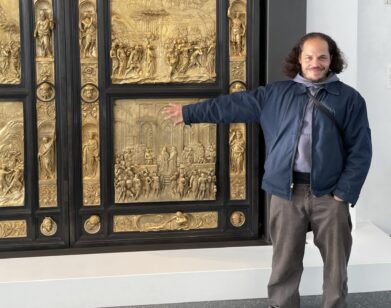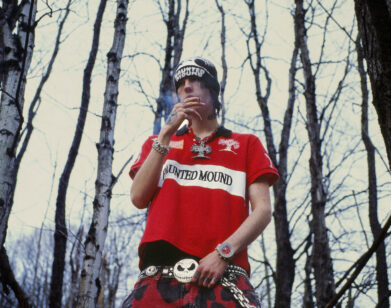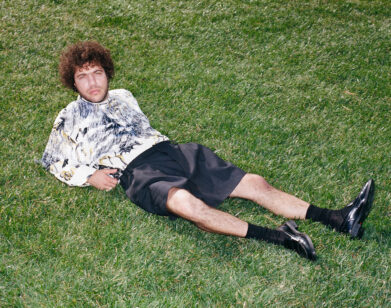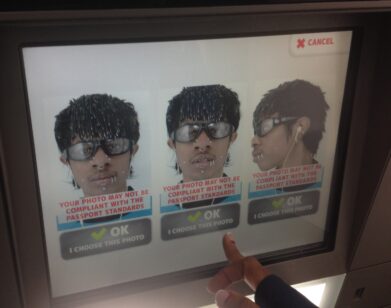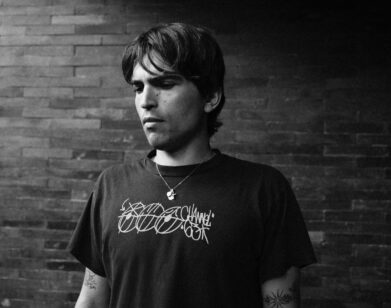Talk Box Wizard
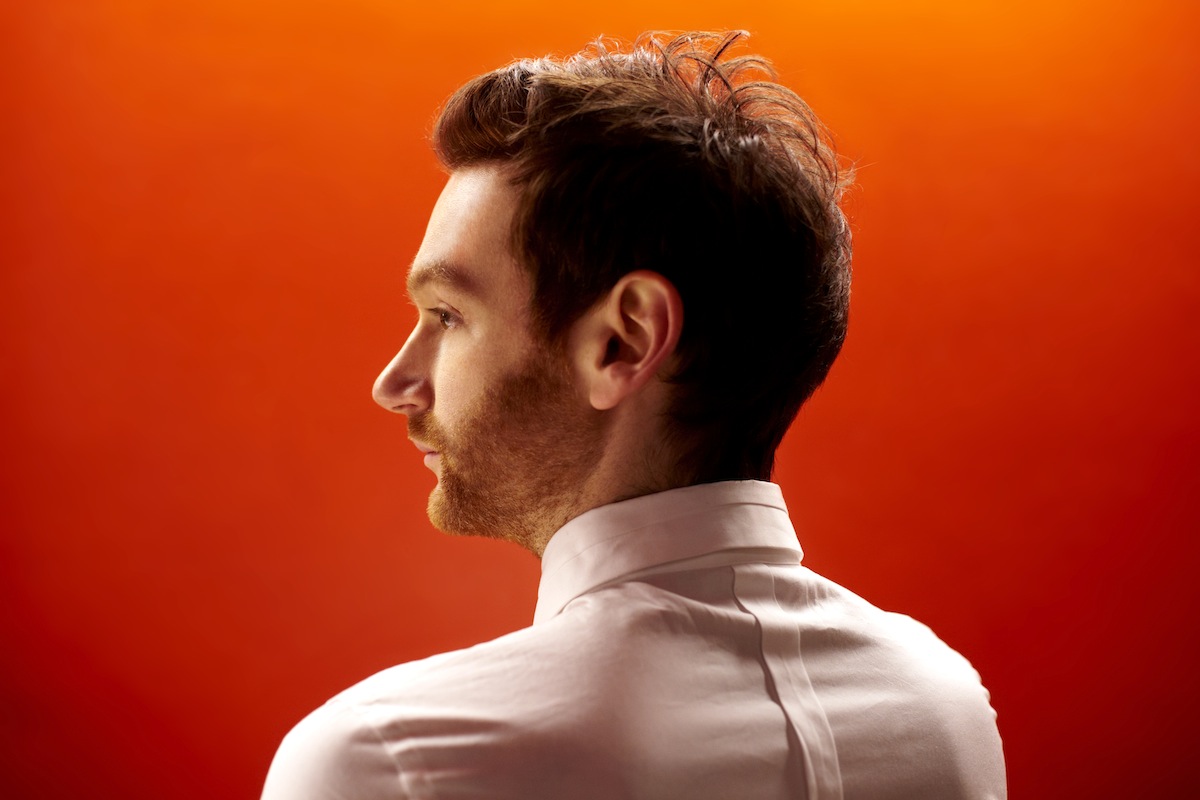
ABOVE: TOM CALVERT, AKA REDINHO. PHOTO COURTESY OF MADS PERCH
“I’ve been going into a lot of clubs, and what I do is a lot different than what’s been happening,” says Tom Calvert (aka Redinho), the first artist to release a full-length album via buzzed-about U.K. label, Numbers. One listen to the self-titled debut’s first single, “Playing With Fire,” and there’s no doubting Calvert’s mild gloat is a justified one. There’s simply nothing quite like Numbers’ secret weapon, and he won’t be secret for long.
The funky production on “Fire” boasts heavily distorted bass, bright percussion, and talk-box vocals. It takes a quick adjustment to the ear, and what at first seems dissonant and abrasive soon turns to the kind of groove mastery you can’t help but scrunch your face and rock to. Redinho’s dance music is as organically physical an experience as it is a sonic one, and yes, it’s incredibly sexy.
In conjunction with the release of Redinho (out today)—which has already gotten praises from BuzzFeed, Dazed Digital, and more—we spoke with Calvert about Redinho’s namesake, traveling the world, and the humanity behind his machine-funk aesthetic.
BENJAMIN LINDSAY: Where are you right now?
TOM CALVERT: I am in my studio-slash-crying-chamber in Southeast London. I don’t know if you know London at all.
LINDSAY: No, unfortunately not. I’m based in New York right now but have never been to London.
CALVERT: I’ve only passed through New York very briefly, so I don’t know New York either.
LINDSAY: Ah, well there you go. Do you have plans to come here at all for touring, or are you overseas for the foreseeable future?
CALVERT: Nothing’s been confirmed, but there’s a few things that might allow me to get out to the States soon. I’ve got some friends out there, as well.
LINDSAY: So tell me, where’d you get the name Redinho?
CALVERT: Yeah, well, sometimes I wonder why I’ve chosen that name because no one can spell it or pronounce it. It’s actually pronounced ree-deen-yo. In Portuguese, it means “Little Red.” My nickname is “Red;” since childhood, that’s been my name. I spent some time in Brazil, and people started calling me that as a joke, really. So yeah, I decided to use that as a name to put my music out.
LINDSAY: Why was your nickname Red?
CALVERT: Just my red hair and freckly face.
LINDSAY: It’s funny, I actually just did this story on an English photographer, Thomas Knights. Have you heard of his photo exhibit “Red Hot”?
CALVERT: Oh yeah, is that sort of trying to remarket redheads almost?
LINDSAY: Yeah, he’s based in the U.K. and just had his opening in New York [a few weeks ago]. But he spoke pretty extensively to me about the prejudice in the U.K. a lot of redheads face. Did you find that people calling you Red was out of maliciousness, or it was just a cute nickname?
CALVERT: I think it’s the latter. My brothers basically started calling me that. It was definitely a term of endearment, but yeah, you definitely get a bit of that growing up in the U.K.
LINDSAY: I’m glad it’s a term of endearment, at least. How did you first come to be involved with Numbers?
CALVERT: It was only three or four years ago now. Before Numbers even was a label, the guys who run it, they all had labels themselves—individual labels—and one of them was a label called Wireblock, and that was run by [a guy] who DJs under the name Spencer. I liked what he was doing, and I sent him a demo, which is actually my first EP, Bare Blips, and he liked it and said, “I’d like to put this out, but we’re starting this new label called Numbers.” It took a while for that to happen and it was the second release on there—on Numbers. And anyway, in that time, they saw me doing the talk-box stuff that I now do, and that’s when they sort of saw some more potential in me, so they signed me to this album deal and since then I’ve been working on that, going around the world a lot, doing a lot of Numbers shows. And now here I am releasing the album! I’m very, very happy to be sharing it with everyone, finally.
LINDSAY: You say it took a little while for them to hear you do this talk-box stuff—have you not always done that?
CALVERT: I’ve done loads of stuff. I grew up playing instruments. I mentioned my brothers before, but they are musicians, as well, and I grew up playing in bands with them. I started out playing the drums. It’s weird because my parents aren’t musical in the slightest. But having those instruments around in the house meant that I was messing around with them and doing a lot of recording and writing. Since then, I’ve learned to play different styles and then got into electronic music and DJing. The talk box is probably on the latter end of all that—it’s just something that I started messing around with.
LINDSAY: It’s funny that it’s one of the last things that you picked up, and now it’s so heavily influenced your sound. What kind of music did you listen to growing up?
CALVERT: Well, Michael Jackson and Stevie Wonder—I still listen to their music and get as much enjoyment as I always have from it, and that’s quite rare, I think. I think a lot of that is firstly because they made great music, but when you associate the music that you grew up with, you’ve got a lot of feelings attached to that; it’s very powerful. It’s a simple example, but I love cycling, and I think one of the reasons I love it is because I did it as a kid, and you bring with it all the feelings that you had as being a child and being quite naïve, but in the good sense of the word, and feeling very free and excited by everything. So yeah, Michael Jackson, I grew up with that. But as I said, I’m an ’80s baby, and being in the backseat of my parents’ car and having that music playing, and also stuff like the Beverly Hills Cop soundtrack—real pop , but amazing stuff. Sort of Phil Collins’, but combined with great songwriting and amazing production and great energy and joyfulness—that’s something I associate with the ’80s. It’s kind of stuck with me.
LINDSAY: How is it that you came to work with Brendan Reilly for “Get You Off My Mind”?
CALVERT: I think he’s originally from California, which is where I used to live—but I met him in London. He’s an amazing singer. He’s kind of been on this soul singer circuit around London, and he’s good friends with Vula, who’s also on my album. She’s another amazing singer based in London who also was born in America. And there’s another girl on the album called Vanessa Haynes. All of those three are highly respected singers in London, and I just sort of have seen them perform when I’m out and about, so it was really nice to get them involved in the album.
LINDSAY: You’ve also recently worked with Remote and Sam Robinson on a visual audio sampler.
CALVERT: Yeah, I’m glad you asked about that, because Remote Location [is] run by a guy named Adam Rodgers. He’s an amazing artist and he does a lot of the visual side of Numbers, and he put together this idea that we kind of worked on a bit together, but he mainly came up with this idea. So, in that sample, there’s a few shots of a kind of monument structure with a bunch of screens on it, and the idea was each of those screens would have a close-up image of someone singing and a close-up image of me playing some of the parts on each tune. The idea is my music, even though it’s pretty human—a lot of it starts with me sitting at the piano and singing and then I produce in a way that’s quite synthetic—the idea was these boxes represented this kind of machine-funk feel, but it was still human at the same time.
LINDSAY: Is that hinting at a greater complete project that’s in the pipeline, or is it just the few minutes that you released?
CALVERT: Yeah, there is a view to try and make it a bigger thing, but it requires a lot of work, so I’m not sure how it’s going to pan out, but there is a long-term vision of that, so look out for that.
REDINHO’S REDINHO IS AVAILABLE NOW VIA NUMBERS. FOR MORE INFORMATION ON THE ARTIST, VISIT HIS WEBSITE.


